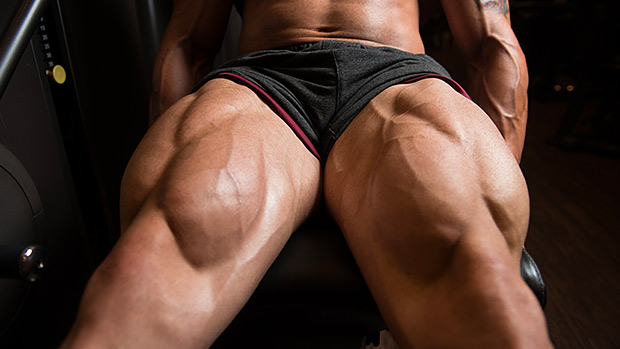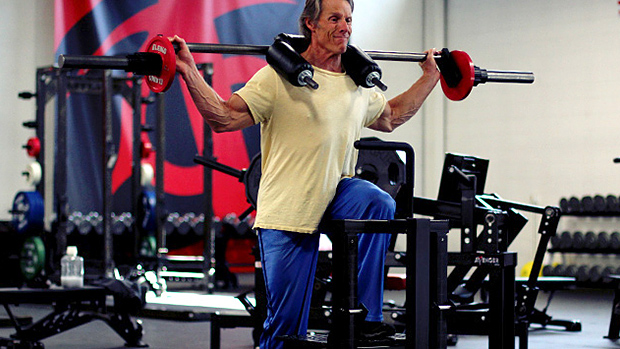Pretty much the only people I see doing leg extensions anymore are old guys wearing undersized basketball shorts that they must have stolen from Larry Bird's locker 30 years ago.
I blame it on the exercise-phys types that coach athletes and the "functional movement" guys. They convinced nearly everybody that any strength gained from leg extensions doesn't "transfer," or worse, that leg extensions are inherently dangerous.
Even amateur bodybuilders tend to avoid leg extensions nowadays, despite them being one of the few movements that preferentially recruits the rectus femoris. Hell, even I occasionally get paranoid while doing them, thinking that at any moment, my kneecap's going to explode out of my leg into some poor bastard's forehead like a beanbag round.
I'm here to tell you all that bad stuff they've been saying about the leg extension is largely crappola, that they're NOT dangerous and that their benefits DO transfer to sport.

I think the notion that leg extensions are bad for your knees probably stems from the fact that it's a "torque-y" exercise.
All the resistance sits on your ankle joints, miles down the road from the muscles that are doing most of the work. As a result, you surely do put some pressure on the anterior cruciate ligament (ACL) and the patellofemoral joint (PFJ).
Even so, in the vast majority of cases, it's no big deal. Let's look at an excellent paper written by T Nation author Nick Tumminello and enlightened biomedical engineer Andrew Vigotsky.
In it, they explain how the ACL can handle upwards of 2000 Newtons, but a leg extension, done with virtually any weight/rep scheme ranging from a max isometric lift to a 12-rep max, only exerts between 158 to 396 Newtons, which is less than one-fifth of what the knee is capable of withstanding.
If your coach were Scotty, the engineer from the starship Enterprise, he wouldn't give you any of that, "Captain, the engines can't take much more of this!" Instead, he'd tell you to take it up a couple of warp speeds because the healthy knee is more than capable of withstanding the forces imposed by the leg extension (as long as you don't go nuts, that is).
But all of what I just mentioned is textbook stuff, and textbook stuff doesn't always transfer to reality. It's like using computer aided design to figure out if the new Piggly Wiggly building will withstand an earthquake. The computer says yes, but you don't really feel 100% confidence until you're able to walk through the aisles during an earthquake and not be buried under a mountain of canned corn and rubble.
That's why it's important to look at real-world stuff. Consider that physical therapists routinely employ leg extensions to "wake up" the rectus femoris after surgery or long-term immobilization. Using them would seem contradictory and downright mean if it really hurt your clients/patients.
There are also multiple studies that have found the leg extension to be useful in rehabbing knee injuries. As an example, a 2016 study of volleyball and basketball players who suffered from chronic jumper's knee (patellar tendinopathy) found that leg extensions done three times a week (4 sets of 8 using a 4-second eccentric movement and a 3-second concentric) for 4 weeks led to a big reduction in pain.
You'll never hear me disparaging squats, but squats will never build the rectus femoris like leg extensions.
If competitive bodybuilders were to rely solely on squats to build their legs, the judges would ultimately penalize them for having "tri-riceps" instead of quadriceps because their rectus femoris would be a wee little thing that never leaves the house without its inhaler.
Regardless, countless trainers will tell their clients to do squats instead of leg extensions, that they're safer, but Tumminello and Vigotsky argue that squats – bodyweight squats, at that – done to 90 degrees of knee flexion, elicit greater peak PFJ stress than EMG (a measurement of muscle response to electrical activity) amplitude-matched leg extensions.
That doesn't mean you should avoid squats, but that the fear of injury from leg extensions is overblown.

It's true that there's no sport or activity where you have to extend your knee under a tremendous load. Even an ass-kicking contest involves all the muscles of the quadriceps, in addition to the glutes and hamstrings.
However, there are plenty of studies that show that when it comes to improving strength, it's better to combine open-chain exercises like leg extensions with close-chain exercises like squats and lunges.
After all, when it comes to strength and sport, you're ultimately better off having developed the whole bouillabaisse of muscles rather than the few that were deemed essential to that activity by some exercise-phys guy in a lab.
The choice of whether to do leg extensions and how to do them should, like any exercise, be tailored to the needs and physiology of the individual. With that in mind, there's this old Borscht Belt joke. Guy says, while repeatedly extending and flexing his lower arm, "Doc, it hurts when I do this." The doc says, "Then don't do that."
Bad joke. Nevertheless, it applies to a lot of exercises, including leg extensions. If they cause pain, "don't do that." Likewise, don't do them using a lot of weight. There's absolutely no reason to max out, or get anywhere near to maxing out, on this torque-y exercise.
Using too much weight is where you'd end up testing all those theories regarding Newtons and such and really risk having your kneecap explode out of your leg into some guy's forehead. In practical terms, stick to rep ranges of 8 to 20. Think volume over intensity.
If you quit doing leg extensions because they hurt, fine, but if you're one of the guys who quit them because of their bad press, think back and recall how, out of all the gym movements you ever did, how they were probably the "burniest." In other words, virtually no exercise targets a muscle as well as the much-maligned leg extension.
It's time to put the movement back in your starting lineup.
- Tumminello N, Vigotsky A. Are the Seated Leg Extension, Leg Curl, and Adduction Machine Exercises Non-Functional or Risky? NSCA Personal Training Quarterly 4.4: 50-53, 2017.
- Mathijs van Ark et al. "Do Isometric and Isotonic Exercise Programs Reduce Pain in Athletes With Patellar Tendinopathy In-Season? A Randomised Clinical Trial," J Sci Med Sport. 2016 Sep;19(9):702-6.




